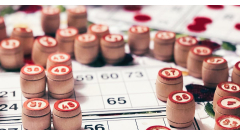Unlock the magic behind player collaboration with this insightful guide inspired by the innovative Tasha's Cauldron of Everything. Delve into a realm where creativity meets strategy, allowing players to forge deeper connections in their adventures. Whether you're a seasoned Dungeon Master or a newcomer eager to enhance your sessions, this guide will illuminate the dynamics of teamwork, offering tips and techniques that captivate and engage all participants.
As we explore the mechanisms of collaboration, you will discover new ways to elevate your storytelling and engage your players. Tasha’s Cauldron fosters an environment where imagination flourishes, and this guide is your step-by-step companion to harnessing that potential, ensuring memorable interactions and thrilling escapades. Get ready to turn those singular adventures into quests filled with camaraderie and shared triumphs!
Tasha's Cauldron of Everything is a comprehensive expansion for Dungeons & Dragons that introduces new rules, character options, and game mechanics to enhance your tabletop experience. This book is designed to empower players and Dungeon Masters by providing tools that foster creativity and collaboration in storytelling. From alternative class features to insights on group dynamics, Tasha’s Cauldron offers a wealth of information to enrich your campaigns and make every session unforgettable.
Creating Collaborative Characters
Facilitating player collaboration in character creation can significantly enhance the storytelling aspect of Dungeons & Dragons, especially with the rules and options provided in Tasha's Cauldron of Everything. Start by gathering all players for a discussion session focused solely on character backgrounds, goals, and connections. Encourage each player to share their character concept while inviting feedback and brainstorming from others. This process helps to establish a community around character development, fostering deeper connections between player characters as they weave their individual stories into a collective narrative.
As players share, prompt them to explore the following elements:
- Background stories: How do characters know each other? What shared history might they have?
- Your goals: What does each character wish to achieve? How do those objectives align or conflict?
- Character motivations: What drives each individual? This can lead to interesting dynamics during gameplay.
- Collaborative elements: Are there any shared secrets, oaths, or missions that bind characters together?
This dialogue should remain open and fluid, allowing players to adjust their character ideas based on group input. Utilize Tasha’s Cauldron of Everything to introduce traits and bonds that can resonate with others, emphasizing how these choices can affect interactions in the campaign. Encourage players to think creatively about how their narratives intersect and how these connections can create shared adventures and emotional stakes throughout the game.
- Encourage brainstorming sessions to refine character details.
- Identify ways characters can take advantage of each other's abilities and skills.
- Discuss potential rivalries or alliances that can enrich the storyline.
Utilizing Group Patrons
To effectively implement the concept of group patrons from Tasha's Cauldron of Everything, it’s essential to foster collaboration among your players. Begin by facilitating a discussion that allows each member to share their character's background, motivations, and aspirations. This practice not only enhances role-playing but will also help the group discover a common goal or theme that resonates with everyone. Once a potential patron is identified, whether it be a powerful organization, a deity, or a noble benefactor, ensure that it aligns with the party’s objectives and values. Throughout the campaign, the chosen group patron can influence various aspects of gameplay, such as quests, challenges, or even boons bestowed upon the players, creating a greater sense of unity and interdependence.
Next, develop a bond with the selected patron by having the players articulate their commitment and describe how their characters interact with this entity. Encourage them to define specific responsibilities or quests that stem from this relationship. This commitment not only strengthens the gameplay experience but also serves as a driving force that motivates characters to work together as they pursue shared objectives. The group should regularly check in on how their actions reflect their fealty to the patron and participate in discussions about furthering this relationship.
- Engage in open dialogue to choose a patron that resonates with the party.
- Define mutual responsibilities or quests assigned by the patron.
- Regularly evaluate how character actions tie back to the patron’s influence.
Encouraging Shared Goals
Facilitating player collaboration in Dungeons & Dragons using Tasha's Cauldron of Everything can be greatly enhanced by encouraging shared goals among characters. In this context, shared goals not only create a strong foundation for teamwork but also enrich inter-character relationships, making the game more immersive and enjoyable for everyone involved. A compelling method for nurturing these shared objectives is through organized brainstorming sessions that engage all players. Gather your group in a casual setting—whether at the beginning of a campaign or during a designated session—and create an atmosphere where ideas can flow freely. Encourage each player to present their character's background, motivations, and aspirations, which naturally leads to discovering commonality among them. Players may uncover shared experiences, desires for growth, or mutual enemies that will ultimately align their characters' paths.
This collaborative spirit can be harnessed further by guiding the players to define a set of collective objectives that align with their individual character arcs. Promote discussions that revolve around potential quests that the party could embark on, or introduce overarching themes that necessitate cooperation. By emphasizing team dynamics from the start, not only do characters develop deeper connections, but players also become invested in achieving those goals together. Consider these strategies:
- Host regular brainstorming sessions to discuss character goals and backstories.
- Encourage players to suggest objectives that resonate with multiple characters.
- Foster an inclusive dialogue where everyone feels heard and valued.
- Update and adapt the shared goals as the story unfolds to keep engagement high.
Implementing Group Challenges
Creating group challenges in Dungeons & Dragons using Tasha's Cauldron of Everything can enhance player collaboration by requiring unique skills from each character. To design these challenges, consider the diverse capabilities and backgrounds of your party. For instance, imagine a scenario where the players need to breach a fortified structure guarded by magical sentinels. Each character can take on a specific role: the wizard uses spells to disable magical barriers, the rogue sneaks ahead to scout and disarm traps, while the fighter leads the charge against the sentinels once they’re vulnerable. Such structured roles create an environment that fosters teamwork and synergy among the characters.
Another engaging example could be a multi-layered puzzle within an ancient ruin. The players might encounter a door inscribed with arcane symbols that require knowledge of different schools of magic to unlock. The bard can use their knowledge of history to interpret the symbols, while the cleric can bless the door with divine insight, allowing the wizard to correctly cast a spell based on the clues provided. As different skill sets come into play, players must communicate and strategize, leading to a more immersive and collaborative experience.
- Encourage creativity by allowing players to combine skills in unexpected ways.
- Offer rewards for teams that work together effectively, such as bonuses or unique loot.
Designing Encounters for Teamwork
Creating encounters that foster player collaboration can significantly enhance the enjoyment of a Dungeons & Dragons game, especially when utilizing the diverse mechanics introduced in Tasha's Cauldron of Everything. Focus on designing challenges that require creative problem-solving and tap into the unique skills of each character within the party. One approach is to create multi-layered encounters where success hinges on teamwork. For instance, a scenario could involve a magical barrier that must be dispelled using various spells, while simultaneously defending against a series of waves of opponents. Encourage players to brainstorm ways to orchestrate their abilities to handle both tasks effectively, making communication key to their success.
Varying the difficulty of encounters can cultivate a rich experience for players. Start with simpler challenges that require minimal cooperation, such as a series of traps where each party member must handle one aspect based on their strengths. As players become more comfortable collaborating, gradually introduce encounters that require tighter coordination, like sieges on a fortified position where rogues need to disable traps while primal characters control the battlefield. Each challenge should leverage the different roles and abilities of characters, prompting them to work together to visualize strategies that utilize every member's strengths for the best outcome. At the end of each session, consider highlighting accomplishments achieved through collaboration to reinforce the value of teamwork.
- Design scenarios that allow for alternative solutions based on character abilities.
- Incorporate time-sensitive elements that require quick group decision-making.
- Utilize environment-based challenges that require teamwork, like navigating through a collapsing cavern.
Promoting In-Game Communication
Facilitating effective communication in Dungeons & Dragons using Tasha's Cauldron of Everything requires nurturing an environment where players feel comfortable sharing ideas and strategizing together. One effective tactic is to establish a collaborative atmosphere by encouraging active listening. Players should be reminded that everyone's contributions are valid, fostering respect for different perspectives. Integrating features such as the "Group Check" from Tasha's Cauldron helps players engage with each other. This rule allows them to work together on challenges, prompting discussions about tactics and approaches. Engaging in regular check-ins during gameplay can also promote dialogue; players should be encouraged to express their thoughts about ongoing events in-game and how they envision their characters evolving.
Implementing shared decision-making mechanisms is essential for building player collaboration. This can be accomplished through open discussions about major decisions, allowing players to voice their opinions on the best course of action. Utilizing break-out sessions during intense moments—where players can briefly huddle and strategize—can be beneficial. Providing opportunities for player-generated content, such as crafting personal quests or backstories that tie into the main narrative, also enhances their investment in the story collaboratively. This encourages the collective shaping of the campaign world while promoting a culture of contribution.
- Encourage players to use character motivations to drive discussions.
- Incorporate mechanics like "Teamwork Feats" from Tasha's Cauldron for cooperative gameplay.
- Use visual aids like maps or game boards during strategy sessions.
- Create time for role-playing to facilitate organic communication.
Incorporating Flaws and Bonds
Utilizing character flaws and bonds in Tasha's Cauldron of Everything can significantly promote player collaboration. Flaws highlight the vulnerabilities of characters, drawing attention to their imperfections that can fuel rich storytelling and character development. When players embrace these flaws, it opens avenues for interaction, as characters may depend on each other for support or guidance. For instance, a character who struggles with trust issues may be paired with a friend who embodies loyalty, creating a dynamic where the former must confront their fears to progress in the storyline.
Bonds, on the other hand, offer players a shared connection that fosters teamwork. When characters have bonds with one another, players are naturally encouraged to approach situations collaboratively, often opting for solutions that require mutual effort. A rogue skilled in stealth could team up with a paladin equipped with powerful charisma to achieve objectives that require both finesse and authority. The overlap between flaws and bonds not only creates complex character dynamics but also solidifies the group's cohesion.
- Encourage players to define their characters’ flaws and bonds early in the campaign.
- Promote character backstories that highlight these elements for deeper connections.
- Facilitate discussions among players that can help them build story arcs that involve their shared flaws and bonds.
Related Products
Utilizing Tools and Resources
To foster collaborative gameplay in Dungeons & Dragons using Tasha’s Cauldron of Everything, explore various digital platforms that streamline communication and planning among players. Tools such as Discord and Roll20 provide virtual meeting spaces where players can share ideas and storylines. Discord’s voice channels allow for real-time discussions, while text channels can serve as archives for campaign notes and character details. Roll20 enhances the experience by offering an interactive gaming board that can help players visualize their campaigns during sessions. Both platforms encourage not only seamless interaction but also creative input from everyone involved, keeping engagement high.
Incorporate visual aids like character relationship charts or party dynamics flowcharts to deepen collaboration. Tools like Miro or Lucidchart allow you to create dynamic visual representations of relationships and plots, making it easier for players to grasp their characters’ connections and the evolving narrative. Moreover, Google Docs serves as an effective collaboration tool for campaign notes, enabling all players to contribute and edit content in one accessible place. Consider gathering regular feedback using SurveyMonkey or similar tools, ensuring every voice is heard and valued.
- Use online spreadsheets for tracking resources and character statistics.
- Engage with online forums or communities to exchange ideas and receive support.
Fostering a Collaborative Environment
Creating a supportive game atmosphere in Dungeons & Dragons using Tasha's Cauldron of Everything is essential for maximizing player engagement and creativity. Collaboration enriches the storytelling experience, allowing everyone at the table to feel involved and valued. When players contribute ideas and decisions, the campaign world becomes dynamic and is shaped by the collective imagination of the group. This co-creative process not only deepens character development but also fosters stronger bonds among players. Encouraging all participants to share their thoughts can lead to unexpected and delightful plot twists that enhance the overall adventure.
Maintaining a respectful dialogue among players is critical for keeping the gaming environment inclusive and accessible. Active listening, where players pay attention to one another's contributions, should be prioritized. This can be encouraged by:
- Setting ground rules for discussion before gameplay begins.
- Encouraging players to build on each other's ideas, fostering a sense of teamwork.
- Implementing a "talking stick" system or similar method to ensure everyone has the opportunity to speak without interruption.
- Providing regular prompts or questions to nudge quieter players into the conversation.
- Modeling respect and politeness by expressing appreciation for diverse viewpoints, even when disagreements arise.
Feedback Loops for Improvement
Creating a vibrant environment for player collaboration in Dungeons & Dragons: Tasha's Cauldron of Everything hinges on establishing effective feedback loops. Begin by setting a regular schedule for feedback sessions, perhaps after each game or at designated breaks. During these sessions, players should feel encouraged to share their thoughts on what collaborative strategies are working well and which aspects might need refinement. A safe, open dialogue fosters creativity and allows the community to adapt and grow together. Utilize tools such as note cards or a shared digital document for players to jot down their thoughts and reflections before each meeting, ensuring everyone has a voice.
During these feedback sessions, consider implementing structured prompts to guide discussions. Questions might include: *What teamwork strategies led to successful outcomes in recent games?* *Are there areas where communication broke down during gameplay?* *How can we better support one another’s characters and individual play styles?* Emphasizing constructive criticism and positive reinforcement encourages a culture of continuous improvement. Following discussions, compile the feedback into actionable items that the group can trial in upcoming sessions to refine their collaborative strategies.
- Encourage players to share personal anecdotes or specific examples.
- Create a feedback-friendly environment by establishing ground rules for respectful dialogue.
- Regularly revisit the feedback to assess if implemented changes are positively impacting teamwork.
Why We Chose This Product
Choosing Tasha's Cauldron of Everything for this guide was an obvious decision. This expansion not only enriches the gameplay but also emphasizes collaborative storytelling, making it a perfect foundation for players looking to deepen their shared experiences. By focusing on its unique approaches to player dynamics, our guide aims to unlock remarkable adventures beyond individual achievements.
- Supports diverse playstyles and group dynamics
- Enhances roleplay and character development
- Encourages creative problem-solving
- Offers tools for inclusive gaming
From its innovative rules to its rich lore, Tasha's Cauldron inspires players and Dungeon Masters alike to create vibrant stories together. This guide will transform your game nights into collaborative journeys that resonate long after the dice have been rolled!
Tasha's Cauldron of Everything is a comprehensive expansion for Dungeons & Dragons that introduces new rules, character options, and game mechanics to enhance your tabletop experience. This book is designed to empower players and Dungeon Masters by providing tools that foster creativity and collaboration in storytelling. From alternative class features to insights on group dynamics, Tasha’s Cauldron offers a wealth of information to enrich your campaigns and make every session unforgettable.










